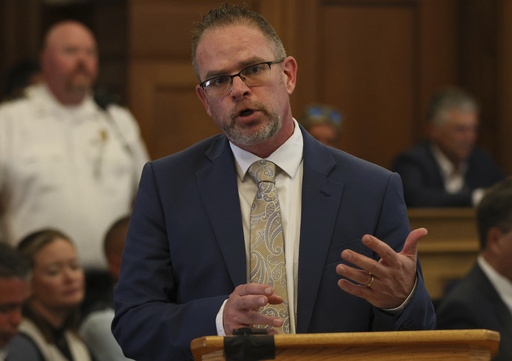DEDHAM, Mass. (AP) — In the heat of early summer, a Massachusetts jury is deciding whether a woman murdered her boyfriend on a snowy winter night, or was framed in a conspiracy concocted by corrupt police involved in the killing of one of their own.
Karen Read is charged with second-degree murder in the January 2022 death of Boston Police Officer John O’Keefe. She’s accused of dropping him off at another officer’s house party after a night of drinking, and then ramming him with her SUV and leaving him to die in a snowstorm. But her defense team argues she was framed, and that the evidence shows O’Keefe was beaten up by someone else inside the house, bitten by a dog and left outside.
It wouldn’t be the first time a turbulent romantic relationship ended in death, and the partner is always a top suspect when an investigation begins. But it also has become easier to question police tactics and integrity after many high-profile cases of misconduct nationwide.
The jury went home Wednesday after a second day of deliberations. They’ve been asked to consider whether the sometimes tiny bits of evidence — pieces of a broken tail light, a single human hair — point to the girlfriend’s guilt, or a sprawling cover-up by law enforcement officers to plant evidence and protect their own, leaving a killer unpunished.
What first might have seemed to be an open-and-shut case has drawn outsized attention, fueled by true crime fanatics, conspiracy theorists and Read’s pink-shirted supporters. In closing arguments Tuesday, defense attorney Alan Jackson rattled off the names of more than a half-dozen prosecution witnesses he said lied on the stand.
“You don’t have to wonder if they would lie to support their narrative, you only need to wonder how many times they did lie, over and over,” he said. “And even when they’re caught in their own lies, they won’t blink, they don’t sweat. They’ll just look you in the eye and demand, ’Pay no attention, you folks. Look the other way.’”
While Jackson argued the state’s entire case boiled down to those four words — Look the other way — Assistant District Attorney Adam Lally narrowed it down to three as he began his final statement: “I hit him.”
Lally reminded jurors that four witnesses reported hearing Read say those words when she returned to the house hours later and found O’Keefe unresponsive on the lawn, covered by snow. Lally also replayed a voicemail he said Read sent O’Keefe hours earlier. Read was “seething in rage,” he said.
“John, I (expletive) hate you!” she screamed. Phone records show she left the voicemail moments after her car recorded her driving in reverse at approximately 24 mph (39 kph) and then driving away, Lally said.
Read, a former adjunct professor at Bentley College, faces up to life in prison if convicted of second-degree murder. She also is charged with manslaughter while operating under the influence of alcohol, and leaving a scene of personal injury and death, which carry maximum penalties of 20 and 10 years, respectively.
The case has divided the community of Canton, the Boston suburb where O’Keefe was raising his niece and nephew after their parents’ deaths and where many of the witnesses and even investigators know one another. And it has attracted hordes of true crime buffs, including some Read supporters who’ve been accused of harassing witnesses.
Prosecutors spent most of the two-month trial methodically presenting evidence including pieces of plastic matching the broken taillight on Read’s SUV. Their witnesses also testified that even before Read returned to the scene and found O’Keefe, she called a friend and screamed “John’s dead!” and raised the possibility that she had struck him.
The defense sought to counter that with evidence that the homeowner’s sister-in-law searched online for how long it takes to die of hypothermia. Jackson said “there’s no innocent explanation” for doing so before the body was found, but the prosecution said she searched for it hours later, and at Read’s request.
The defense called only a handful of witnesses over two days but used cross-examinations to suggest countless conflicts of interest and staggeringly sloppy police work, from a scene left unsecured for hours to blood-stained snow scooped up with red plastic drinking cups and the use of a leaf blower to clear snow. Jackson listed more than two dozen suspicious behaviors, including deleted search histories, destroyed phones and manipulated videos.
“It’s not that it could happen, it’s that every single one of those things I just mentioned did happen,” he said.
Jackson said investigators focused on Read because she was a “convenient outsider” who saved them from having to consider other suspects, including the homeowner, Brian Albert, and other law enforcement officers at the house party. He also pointed to connections between Albert and the state trooper who led the investigation.
“Michael Proctor didn’t draw a thin blue line, he erected a tall blue wall,” Jackson said. “A wall that you can’t scale, a wall that Karen Read certainly couldn’t get over. A wall between us and them. A place you folk are not invited. ‘We protect our own.’”
A block from the court, dozens of Read supporters were glued to their phones awaiting a verdict. Their mood was jubilant, with supporters chanting, waving American flags and getting encouragement from passing motorists who honked their horns.
“She was unjustly charged and we are hoping she can go home today,” said Vicki Walkling, a supporter dressed in pink. “This case has enraptured everybody because it’s unfair. It could happen to any one of us. Any one of us could be framed for a murder we did not commit.”
____
Ramer reported from Concord, New Hampshire. David Sharp in Portland, Maine, also contributed to this report.
Home US News Massachusetts Karen Read’s jurors weigh evidence in a murder trial that challenged police...
